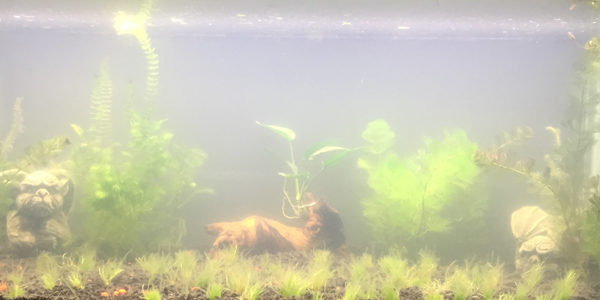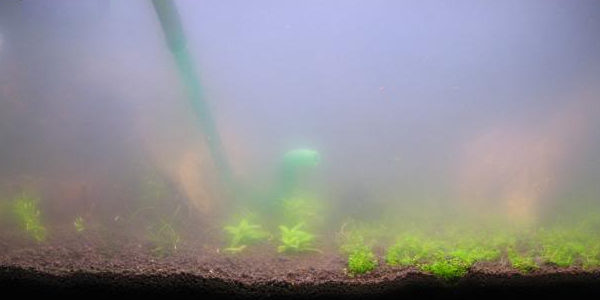Almost all aquarium owners have experienced enjoying their fish swimming about in crystal clear water one day and the next everything is cloudy – you are experiencing a cloudy aquarium water issue.
What happened?
You might not hear a lot about it, but cloudy water is definitely a concern in aquariums, especially freshwater.
The bad news is almost all aquarium owners experience cloudy aquarium water, from the first timer to the veteran.
While it does not typically pose any actual threats to the well-being of your fish, it will definitely make the tank appear unsightly and may negatively effect the quality of water.
Fortunately, cloudy aquarium water is something that can be prevented.
The best way to go about preventing cloudy water is to learn the cause of it and how to treat it.
Let’s dive in!
Table of Contents
What causes cloudy aquarium water?

Once you are aware of cloudy water in your tank, the first step to fixing it is to figure out what caused it.
As unlikely as it may sound, one of the most common causes of cloudy tank water is biological.
Bacteria live in a symbiotic relationship with the other inhabitants in the tank.
However, if the amount of bacteria in the aquarium increases suddenly, there can be what is known as a bacterial bloom.
This bloom can cause the water to appear cloudy.
This bacterial bloom is commonly seen in newly setup tanks that may not have had their water cycled properly.
Helpful bacteria break down waste products from the fish and plants in your tank.
This cycle, known as the nitrogen cycle, breaks down toxic chemicals such as ammonia into benign chemicals such as nitrates.
If waste products build up, it can lead to an increase in these bacteria, which can lead to a cloudy tank.
But what about algae?
Besides bacterial bloom, algae bloom can cause cloudy water.
Algae are mainly a nuisance and pose no serious threats to your aquarium’s environment.
However, they are a prime candidate for cloudy water.
A good rule of thumb is that an algae bloom will cause cloudy water to have a greenish tint, whereas a bacterial bloom will not.
Algae blooms are common in tanks that have an overabundance of carbon dioxide, light, or nutrients, either from overfeeding or waste build-up in the substrate.
If you notice cloudy water with a greenish tint, check for sunlight exposure or keep your artificial lights on a shorter schedule.
Dirty, dirty substrate
If algae and bacteria are not the cause, a third possibility is a dirty substrate.
Many novice aquarium owners make the mistake of plunging their carefully selected substrate under the water as soon as they get it home.
However, much like anything else you’ll be entering into your underwater environment, you’ll want to thoroughly rinse the substrate (or gravel) before placing it in order to rid your tank of any dirt or dust.
The easiest way to accomplish this is to place the substrate into a water-tight container and hold it under running room temperature water.
Feel free to stir gently with your hand or a wooden serving spoon.
When the water pouring over the side of the container runs clear, you can rest assured that it is free of dirt or dust build-up and is now ready to place in the tank.

Take two pills and call me in the morning
If you’ve already discovered cloudy aquarium water, then it’s time to talk about treatment options.
Depending on the expertise level of the staff at your local aquarium supply store, you may be pointed in the direction of water clarifying tablets.
While these might clear up the water in your tank for a few days, they do not address the underlying problem, meaning the cloudy water is bound to return.
Another warning in regards to clarifying tablets is that you don’t always know what the unintended side effects might be.
Adding any sort of chemical to your aquarium is always a risk, but it is higher if you are not aware of all of the side effects.
Do Your Research
Thoroughly research anything before you add it to your environment.
You would never want to inadvertently harm your fish just for the sake of temporarily clear water.
Rather than relying on a quick fix, take the time to research the issues in your tank and choose an appropriate solution.
The main issue is improving the water quality in your aquarium.
Use an aquarium gravel vacuum to remove the gravel from the bottom of your tank.
This will remove any accumulated debris that may be damaging the water content in your aquarium.
Once that is complete, replace a quarter of the water in the tank with aquarium conditioned water.
You might not see immediate results, but if the cleaning is done according to these directions, you’ll improve the water quality guaranteeing a reduction in algae, bacteria, and detritus.
You’ll be back on your way to crystal clear water in no time.
Share your experience
Have you experienced cloudy water in your aquarium?
Share with us how you overcome it by commenting below.

2 thoughts on “Cloudy Aquarium Water: How to Overcome it?”
I have researched all websites on how to clear a cloudy aquarium. All of their advice is the same, except for the fact that they do not address exactly what it is you’re feeding your fish. Yes, they all say “don’t overfeed your fish”. But the problem may be much more exacting and should also ask “what are you feeding your fish?” I have a nano tank, 6.7 gallons, and problems are much more concentrated in such a small environment. Believe me, I tried everything and then hit on another idea, “is the actual food I feed them contributing to a cloudy tank?” My experiment would have to answer a resounding “yes”. I was feeding my two corys one or two Hihari Algae Wafers a day which they loved and ate them with relish. I assumed they ate all the food because I saw nothing residual the next day. But I decided to test the turbidity which this particular food may cause. So, I placed a wafer in a glass of water and lo and behold, the next day the water in that glass was just as cloudy as my aquarium. I didn’t feed them the algae wafers after a 50% water change and the next day, the clarity of the water was improved by 50%. So, my conclusion is don’t just be mindful of how much you feed, but also, how much are the products one uses contributing to a cloudy tank. Many products will contribute to this condition and no matter what you feed them, do so very sparingly, especially in a nano tank environment and always ask yourself “is this food causing a very dirty condition in my tank? Going forward, I intend to break those algae wafers into much smaller pieces that I know my corys can consume within minutes. I hope this revelation will help all those who suffer from cloudy aquarium conditions, with no other hope in sight. It has certainly helped my aquarium.
i had my tank running for 2 moths before i put fish in it. the water started getting cloudy the day BEFORE i was to buy the fish. i have been running it now for another month with out fish and it is still cloudy